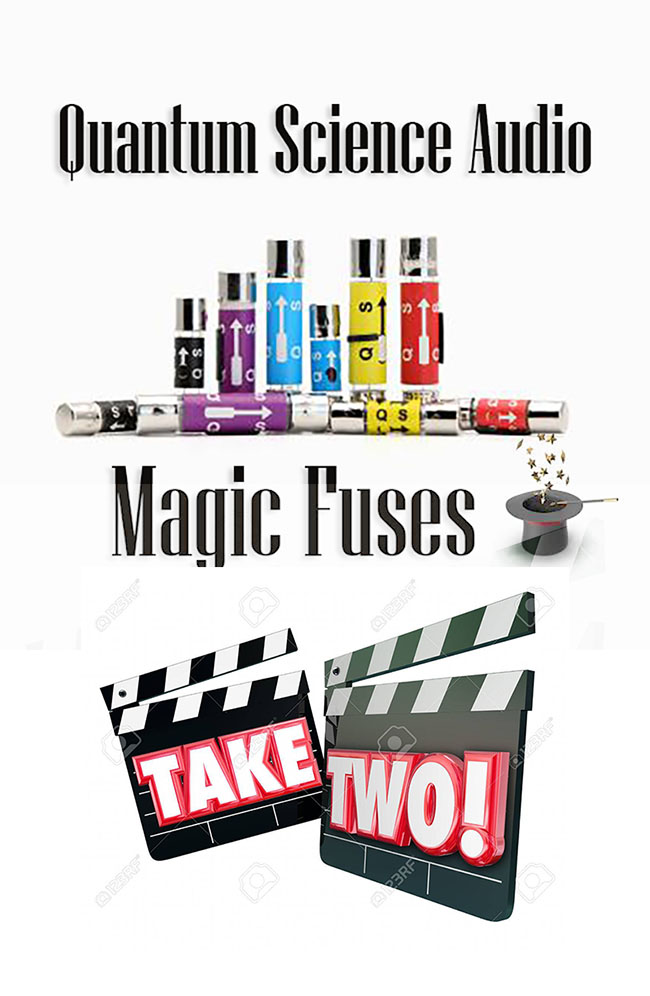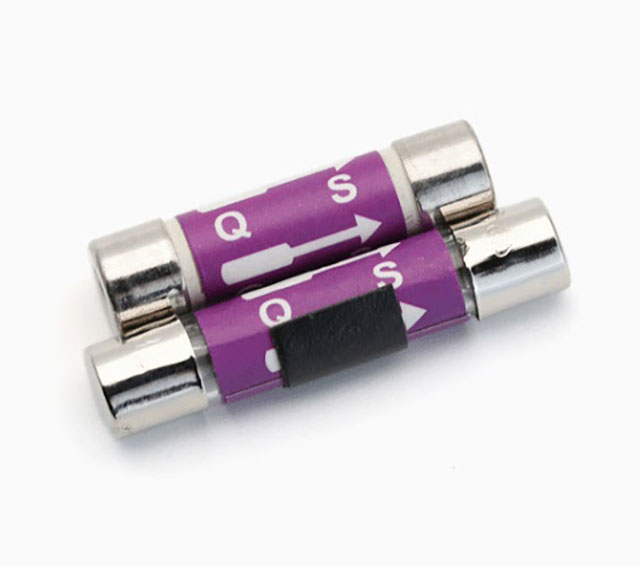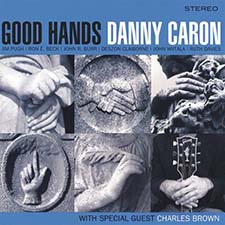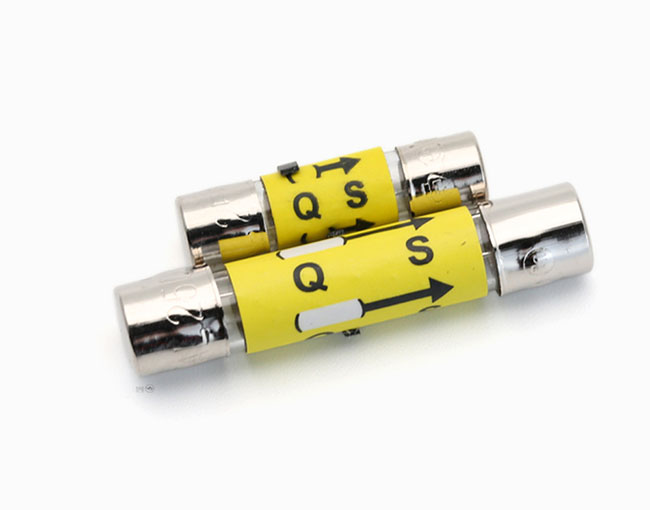Quantum Science Audio series Purple Fuses by Mike Wright and Greg Voth

 Quantum Science Audio Purple Fuses – The Follow-up
Quantum Science Audio Purple Fuses – The Follow-up
This essay should serve as a follow-up to Clement Perry’s excellent Quantum Science Audio Series Fuses (reviewed here). I need to share a little background information with your readers to grasp my point of view on the Quantum Science Audio Purple (hence QSA Purple) fuses. Ever since I first met Clement in 2003, he has been searching for anything that would help him achieve “audio nirvana.” He does not limit his search to electronics only, but he investigates “tweaks” with the best of them. I would not describe him as obsessive, but if it makes sense, he will try it. On the other hand, I am a bit more skeptical, probably like most of you guys. So, I humored him when Clement reached out to me to share his experiences with these fuses from QSA.
I would respond to his stories of the QSA adventure with, “Wow, that’s cool, outstanding.” Even when he insisted that I hear the experiences of some of his audiophile friends and fellow Stereo Times reviewers and even did a conference call with them, I was not biting. Think of the late John Candy from the film “Planes, Trains, and Automobiles” when the couple driving in the other car tried to tell him he was going in the wrong direction down the interstate. There’s just no “farthing” way I would even consider trying, let alone buying a fuse, especially fuses at that ($711) price point, regardless of Clement and his friends’ experiences and conviction. Nope. I can’t do it. No way, no how. The thought never entered my consciousness. You know, like most of you readers would probably react. There was much incredulity. However, a couple of months after the initial audio fantasy he shared with me, Clement called to let me know that he was sending out a couple of fuses for me to audition! Convinced that I would appreciate them and could hear somewhat of what he was hearing, I felt like, “Whatever, dude.” About a month or so later, the QSA Purple fuses arrived.
Let the listening begin.

How It Sounds
 It is just a fuse with a purple-colored label and an arrow. That is all I saw. My first thought was, how is this little QSA Purple fuse going to be all the wonderful things Clement was touting? I had not even read his review initially because I was not a believer. Then I inserted the fuse into my VAC Renaissance V preamp to start and later added them into my VAC 200 iQ amplifiers. Initially, I sensed something was a little different enough to stop talking to the wife upstairs. Yeah, this sound was slightly different, but not necessarily better, or so I thought initially. I was trying to wrap my brain and my ears around what was subtly creeping up on me for that first 25-30 minutes. I was not quite ready to become a QSA believer just yet. By the time I got to the 45-minute mark, it was as though someone pulled the stopper out of the sink and all the water of doubt started to run out.
It is just a fuse with a purple-colored label and an arrow. That is all I saw. My first thought was, how is this little QSA Purple fuse going to be all the wonderful things Clement was touting? I had not even read his review initially because I was not a believer. Then I inserted the fuse into my VAC Renaissance V preamp to start and later added them into my VAC 200 iQ amplifiers. Initially, I sensed something was a little different enough to stop talking to the wife upstairs. Yeah, this sound was slightly different, but not necessarily better, or so I thought initially. I was trying to wrap my brain and my ears around what was subtly creeping up on me for that first 25-30 minutes. I was not quite ready to become a QSA believer just yet. By the time I got to the 45-minute mark, it was as though someone pulled the stopper out of the sink and all the water of doubt started to run out.
It was like watching a time elapsed video of a flower opening its petals and starting to bloom. I was already enjoying the sound coming from my system but began to enjoy it even more so. The degree of realism, inner detail, and presence got noticeably better. When the upright bass was being played, I could feel the sensation of the cords vibrating in the air and in my room, as was the presence of the action of the fingers moving up and down the cords. The edges of my soundstage became much more defined, while tonal colors were more vibrant. The high frequencies sounded freer, easier, clearer, and distinct. My transient response has always been good, but via the QSA’s magic, they were faster and had more detail. After the first hour of listening, I began to think that maybe I should double-check my system set-up and make sure my preamp was not suddenly running hot or that my tubes were giving the absolute best of what they had before they burned out. There was nothing about my system’s operation that was outside of the ordinary. Satisfied that this was not an aberration, I returned to just enjoying my newfound level of performance. I enjoyed the feeling that every instrument, every vocalist, every album, stream, or CD I played sounded better than what I had previously heard. This sound was not nuanced. These were developments that were easy to listen to and follow. In terms of my bass performance, aside from a bit extra extension, I could hear, there was a character in the decay of the notes at the bottom end that showed improvement. I could get a little bit more shudder and rumble in my room when the bass notes began to reveal themselves, especially with kettle drums and low notes emanating from organs.
 Guitarist Danny Caron’s Good Hands [CD Baby] was the first album I listened to that drew my attention to what the QSA Purple fuses could do. I found this recording to be more enjoyable and the music easier to get into with the QSA Purple fuses in place. I have always enjoyed listening to Mr. Caron’s combination of bluesy-jazz style of playing, but now he seemed to be playing with more verve, rocking, and jamming with his guys on this offering. Even more revealing was Jim Pugh’s range on the electric keyboards. Mr. Pugh comes off as very lively and soulful on his instrument, especially with the up-tempo, Shaggin’, and a moving rendition of, A Rainy Night in Georgia. I would be remiss if I didn’t mention how good the great Charles Brown’s life-like vocals were as well on I Wonder Where Our Love Has Gone. A new and exciting jazz trumpeter I have been listening to lately is Christian Scott and his double album “Christian aTunde Adjuah” [Concord]. There is a lot of fine music to be heard here, and I like Mr. Scott’s bell-trumpet tone. I am mainly a fan of his mellower tunes such as Who They Wish I Was, I Do, and Kiel.
Guitarist Danny Caron’s Good Hands [CD Baby] was the first album I listened to that drew my attention to what the QSA Purple fuses could do. I found this recording to be more enjoyable and the music easier to get into with the QSA Purple fuses in place. I have always enjoyed listening to Mr. Caron’s combination of bluesy-jazz style of playing, but now he seemed to be playing with more verve, rocking, and jamming with his guys on this offering. Even more revealing was Jim Pugh’s range on the electric keyboards. Mr. Pugh comes off as very lively and soulful on his instrument, especially with the up-tempo, Shaggin’, and a moving rendition of, A Rainy Night in Georgia. I would be remiss if I didn’t mention how good the great Charles Brown’s life-like vocals were as well on I Wonder Where Our Love Has Gone. A new and exciting jazz trumpeter I have been listening to lately is Christian Scott and his double album “Christian aTunde Adjuah” [Concord]. There is a lot of fine music to be heard here, and I like Mr. Scott’s bell-trumpet tone. I am mainly a fan of his mellower tunes such as Who They Wish I Was, I Do, and Kiel.
The style and dynamics span a wide range from being vibrant, fast, and dynamic to sounding ethereal and melodious, as you would get from Miles Davis or Chet Baker. The change to the QSA Purple fuse allowed me to enjoy the recording more because a lot is going on. The tonal colors became more brilliantly meaningful, as did Mr. Scott’s ability to convey his thoughts musically. Then there’s Trilok Gurtu and his large percussion set on “Spellbound” [Sunny Side]. This CD’s Gurtu’s homage to great jazz musicians on trumpet, like Mikes and Diz. At the same time, his drum playing is very dynamic. I was particularly fond of the arrangement on Manteca, which sounds like jazz – with a blend of Middle Eastern and American melodies. Again, this was an excellent recording in my system before the infusion of the QSA Purple fuses but became much more energetic, livelier, and more present after the fuse change.
A Few More Thoughts
 Okay, yes, Clement was right about the performance of the QSA Purple fuse. When I called him the next day after an evening/night of listening, I was effusive in praising the QSA Purple fuses. He had heard it all already, especially from his friends that said no way would a fuse do all that and that they are cost makes them unobtainable. Well, sometimes you hear something that sounds a little too good, to the point where they become addicting, like an audiophile drug or addiction. This was especially so when he sent me two more QSA Purple Fuses to insert in my VAC 200 iQ Signatures. Listening to just one amp in stereo was pleasurable but running both in mono became sublime with the QSA Purple fuses. There is just more “there” there. My system painted a sonic picture with more air, even more presence, detail, musicality, and a larger tonal pallet. But really, three Purple fuses???
Okay, yes, Clement was right about the performance of the QSA Purple fuse. When I called him the next day after an evening/night of listening, I was effusive in praising the QSA Purple fuses. He had heard it all already, especially from his friends that said no way would a fuse do all that and that they are cost makes them unobtainable. Well, sometimes you hear something that sounds a little too good, to the point where they become addicting, like an audiophile drug or addiction. This was especially so when he sent me two more QSA Purple Fuses to insert in my VAC 200 iQ Signatures. Listening to just one amp in stereo was pleasurable but running both in mono became sublime with the QSA Purple fuses. There is just more “there” there. My system painted a sonic picture with more air, even more presence, detail, musicality, and a larger tonal pallet. But really, three Purple fuses???
I decided that the QSA Purple price was prohibitive and as wonderful as it sounded; indeed, can comparable performance be found with less expensive fuse offerings? Being a curious audiophile, same as some of you guys, I immersed myself in everything related to fuses. One thing my investigating showed me was that more of my friends than I had imagined had aftermarket fuses in at least one or more of their audio pieces. Hindsight had me ask myself – where was I, and why hadn’t I jumped on board with this fuse phenomenon earlier? My search to find the “QSA fuse killer” led me to purchase a couple of Synergistic Research Orange and HiFi Tuning Supreme fuses. This undertaking was a lot of work, plugging fuses in, pulling them out, turning them around, checking their orientation, listening to and evaluating each change. Finally, after 2-3 weeks, I gave up and reached at least a couple of conclusions.
The first is that some aftermarket fuses are not that much better than stock fuses, and some are better, like the HiFi Tuning and Synergistic Orange fuses. The second realization I had was: I wish I had listened to the Synergistic Orange or HiFi Tuning fuses first. Despite the improvement they brought to my system, I did not feel that they performed to the level of the QSA Purple fuses.
Clement decided to stoke the flames of my audiophile confusion by sending me a couple of QSA Red fuses. Arrrggghhhh!! I’d be darned if they didn’t sound even better than the QSA Purple fuses. I had earnestly hoped they would not be much better at all, but they were as Clement had described to my dismay. By then, I just sat there in my listening room and decided to forget about going through the litany of adjectives and superlatives. Sounding like a thesaurus kind of defeats the purpose, but suffice it to say, they delivered as promised. The sound had even more musical realism, more presence, and more enjoyment. I could not handle that heightened level of performance that the Red fuses revealed, especially knowing I could not afford them. After several hours of pleasure, I decided I had enough of the psychological torture of knowing the QSA Red had to go back. A weaker audiophile would have snapped under pressure. There is no way I can think of to try and tell you that you should pay such exorbitant prices for fuses. I am sure manufacturers test and evaluate the fuses they use in their gear and are generally satisfied with the finished product. What especially gives fuses a bad vibe is when audiophiles use the wrong value fuse while trying to get increased performance. That is never a good idea whether you get away with it or not. I can share with you readers the increased performance to be had with some/most aftermarket fuses and that the QSA fuses are some of the best available at any price. Yes, they are expensive, absolutely, but at the same time, they can unlock a level of performance your beloved amplifier, or preamp, DAC, or CD player has contained within. My VAC 200 iQ amplifiers are some of the best performing amplifiers I have heard, and I would not swap or trade them to get anything else. When I put the Purple fuses in them, I was stunned, and at the same time gratified, to hear the increases of performance they provided.
Considering how expensive a VAC preamp and a pair of stereo amplifiers are, the $2K cost of the QSA Purple fuses juxtaposed with the increased performance; I feel my investment has been maximized. That is why I can say, if you are looking to get the best out of what you have, or are thinking about replacing your electronics, try a QSA fuse first. You may wind up saving yourself some money. Suppose you are looking to elevate the performance of your cherished audio equipment, based on my experience. In that case, I can wholeheartedly recommend the QSA fuses, particularly the Purple and the even better Red ($1422) fuses. I would give them my “highest recommendation.” Keep in mind; Clement says that QSA has a couple of levels of fuse performance beyond the Purple and Red. That evaluation should prove to be very interesting.


mike wright


 In mid-April, I changed out the stock rear breaker and four fuses in my SBS Designs S2 Pro power amp for a Quantum Science Audio Yellow four fuses ($213 each), careful to orient the arrow on each fuse in the same direction.
In mid-April, I changed out the stock rear breaker and four fuses in my SBS Designs S2 Pro power amp for a Quantum Science Audio Yellow four fuses ($213 each), careful to orient the arrow on each fuse in the same direction.
That direction is an entirely random choice on your part, but the consequence, if oriented incorrectly, will reveal a noticeable degradation in sound quality. Should that happens, simply shut down and reorient the fuse(s) in the opposite direction, hence the need for the reference arrow on each fuse.
Not long after, Clement texted, curious about what I was hearing. I texted back, “Wow Clement, this really is astounding. It’s doing the great depth thing… drums way back. I’ll bet I have the fuses inserted in the right direction – if I don’t, you’ll have to pick me off the floor when I hear ’em the other way!”
I followed up with a series of texts that I’ve linked in one statement here “These babies are no joke. The upright bass is walking right out of the speakers. So much more visceral, physical, powerful. The brushes and percussion and bass sound great – right in the room. Bass is much more powerful, soundstage far more apparent… more lively more musical. Brushes and small snare fills are so much more exciting.”
The QSA Yellows were only in for a short while before they moved on. Back in went my original stock fuses. Away went the improvements I heard – while still very good, my rig lacked the increased musicality heard with the Yellow products installed.

A couple of months later, four QSA Purple fuses (at $711 each) came my way. I oriented the fuses in the same direction as randomly chosen for the Yellows install. They remained for the next few weeks.
 The install direction for these fuses is, at first, a random choice. Inserted in the “proper” direction, you’ll notice increased musicality, naturalness, air, and resolution. To my ear, the naturalness and increased musicality weigh heaviest. The Quantum Science Audio products “won’t make a silk purse out of a sow’s ear” – they can’t elevate a poorly recorded or produced track to one to die for. They, however, will reveal their weaknesses. The QSA’s will elevate a superior track while a lesser track’s faults will be more evident.
The install direction for these fuses is, at first, a random choice. Inserted in the “proper” direction, you’ll notice increased musicality, naturalness, air, and resolution. To my ear, the naturalness and increased musicality weigh heaviest. The Quantum Science Audio products “won’t make a silk purse out of a sow’s ear” – they can’t elevate a poorly recorded or produced track to one to die for. They, however, will reveal their weaknesses. The QSA’s will elevate a superior track while a lesser track’s faults will be more evident.
At the end of June, I flipped the QSA Purple fuses to confirm their proper orientation and texted,” Things became more open but bass seemed over wide, bloated and indistinct. Flipped fuses back – low mids and bass have far greater impact, PRAT seems on steroids and percussion has far better transients.” Properly installed, the QSA Purples offered up better grip and more body. My wife, Robin, and I heard increased bass output and an apparent dive in bass frequency through the Tekton Double Impacts. I turned to her and asked, “Why would anyone ever need a subwoofer?” The low-level retrieval sounded just wonderful. Robin’s always laughing at things and calling them ‘snake oil,’ just to poke fun.
I had intended a show-and-tell by reversing the fuse direction so she could witness the changes but nixed the idea.
I don’t need to prove anything further to myself or anyone else for that matter.


greg voth
Specifications:
Price:
Mike’s Associated Equipment:
Speakers
Tekton Design Moabs
Amplifier
VAC Signature 200 iQ Amplifiers (used as stereo and monoamps)
BSC Audio BSC100m 100-Watt Mono-amps
Preamplifier
VAC Renaissance Mk V with Phono
Analog
Merrill Heirloom Turntable
Rowland Research Consonance Tonearm
Transfiguration Phoenix Cartridge
Digital
Asus Laptop w/Fidelizer Pro, Roon, and JRiver v.26 for Hi Res Files
Holo May Kitsune III DAC
Bricasti M5
Marantz SA-7S1 CD Player
Cables
Dynamic Design Heritage Balanced Interconnect
Dynamic Design PAAPI
Silversmith Fidelium Speaker Cable
Pink Faun USB
AnnaLyric Power Cords
Essential Sound Product Essence II Power Cords
Power Line Conditioner
Inakustik 3500P (Distributor loan)
Essential Sound Products Essence Power Distributor
Accessories
Star Sound Apprentice & Rhythm Platforms – for amps
Star Sound Sistrum Rhythm Two Platform Stand
Symposium Acoustics Ultra Platform
Symposium Acoustics HDSE Rollerblocks
Symposium Acoustics +2 Rollerblocks
Adona GX4 Equipment Stand
Epiphany Stand Systems – Celeste Reference Stand
Stereo Times Masthead
Publisher/Founder
Clement Perry
Editor
Dave Thomas
Senior Editors
Frank Alles, Mike Girardi, Key Kim, Russell Lichter, Terry London, Moreno Mitchell, Paul Szabady, Bill Wells, Mike Wright, Stephen Yan, and Rob Dockery
Current Contributors
David Abramson, Tim Barrall, Dave Allison, Ron Cook, Lewis Dardick, Dan Secula, Don Shaulis, Greg Simmons, Eric Teh, Greg Voth, Richard Willie, Ed Van Winkle, and Rob Dockery
Music Reviewers:
Carlos Sanchez, John Jonczyk, John Sprung and Russell Lichter
Site Management Clement Perry
Ad Designer: Martin Perry






Be the first to comment on: Quantum Science Audio series Purple Fuses by Mike Wright and Greg Voth